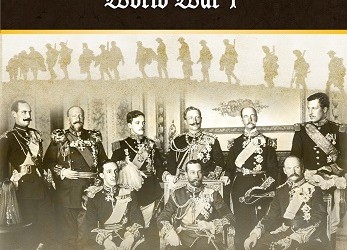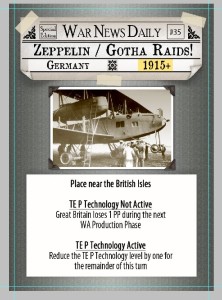By Hermann Luttmann:
ERRATA and FAQ’S
ERRATA
- U2 Tech Card
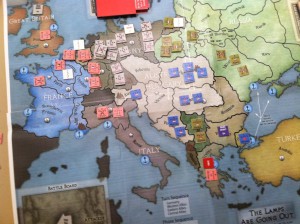 : The card is incorrect – the text in the rules is correct (i.e., all German Fleets get one re-roll of all their combat dice)
: The card is incorrect – the text in the rules is correct (i.e., all German Fleets get one re-roll of all their combat dice)
- East Asia Squadron Event Card: The corresponding fleet marker is automatically removed at the end of 1915 (if not eliminated by then). The card should have “Remove marker at the end of 1915”.
- WA Inspired Leadership, Brusilov Offensive and Lettow-Vorbeck Campaigns Event Cards: These cards with the special “re-enter” ability are always valid when drawn – the date is just their first year of entry into the game. These “Date” entries can also be read as “*1915+*”, “*1916+*” and “*1916+*” respectively.
- Gallipoli Port: The “anchor” symbol between Gallipoli and Anatolia should be closer to Gallipoli, as it applies only to that area.
Shackled to a Corpse: The effects of this card need some more detail, as follows –
- The -1 drm on A-H attacks is in effect for the remainder of the game;
- The effect can be cancelled for the current turn (only) in two ways –
- Germany can spend 1 PP during its Production Phase and transfer it to A-H. Place a “1 PP Transfer” marker directly onto the “Shackled” marker to indicate this expenditure has been made and that the A-H attack penalty is cancelled for the upcoming CA turn. Note that this PP transfer is a separate event from the normal PP transfers and it cannot be used by A-H for production nor does it count against the normal maximum 3 PP transfer limit from Germany to A-H;
- Any German unit (in any condition) in an area with attacking A-H units will cancel the attack penalty for those A-H units as long as it shares the area with them. The German unit itself need to not attack.
- Austro-Hungarian Fleet Sortie: The effects of this marker are actually the following –
- Remove 1 PP from any PPs that were transferred to Italy this turn;
- No strategic Sea Moves allowed to the anchor areas of Northern Italy, Rome, Greece, Gallipoli or Sinai while marker on map. Note that this means that normal strategic Sea Moves can still be made to Basra;
- No PP Transfers allowed by Sea Move tracing to the anchor areas of Northern Italy, Rome, Greece, Gallipoli or Sinai while marker on map.
- Dardanelles Forts Reinforced: The Dardanelles Heavy Artillery (DHA)unit actually has some special abilities and restrictions that are not all listed on the card –
- It may not move from Gallipoli nor may it ever attack;
- If alone – the DHA defends itself with two dice and there is no regular Garrison. If it is defending against an Amphibious Landing, it will roll three dice. If two or more of those three dice beat the attacker, the attacking unit is eliminated. If only one of those dice defeat the attacker, the attacker is placed in a Beachhead. If the DHA is defeated in combat, it is eliminated.
- If with a friendly unit in the same area – the DHA acts like a normal Heavy Artillery unit with the “C1” technology ability (only) but it may not be used to aid an attack. If it is forced to Retreat (because the other friendly units are forced to Retreat), it is eliminated instead.
- Tanks and Mountains: The “Tanks” unit may not use its special ability attacking into a Mountain area. It may move into such an area normally and it may use its special ability when attacking out of a Mountain area normally as well.
FAQ’s
- US Unit Sea Moves: In order for US units to move to a French area from the US to France, there must physically be a French army unit in that area.
- Greece and WA Units: While only one WA unit is allowed in the Greece area at any one time, there is no limit to how many WA units may pass through Greece (and conduct operations in the Balkans and elsewhere). If there is a WA unit in Greece and another WA unit retreats into it (for example, from Serbia), the retreating unit could not remain in Greece and would be naval evacuated instead (placed back into the force pool).
- Basra Attrition: The more expensive 2 PP cost to Refit a unit on the “Basra” Near East Track outside of the actual Basra area applies only to non-Turkish units (friendly and enemy). Turkish units on that track always pay the normal 1 PP cost.
- Heavy Artillery Units and Trenches: Heavy Artillery units can be used to attack enemy Trenches and are still “Fired” doing so. With the “C1” Tech card in play, Heavy Artillery units may be used to defend friendly Trenches and are “Fired” for doing so.
- Austro-Hungarian Artillery Unit Availability: There are only two A-H Heavy Artillery units in the game but three opportunities to bring them in – the “A1” and “C1” Technology Cards and the Skoda Works Event card. If both units are in the game when a third opportunity presents itself, simply ignore the card.
- They Shall Not Pass: When determining how many friendly units have been permanently eliminated for the Tenacity Test, count all Army units from the same Nation as the testing unit. This includes special armies like Lettow-Vorbeck, MEF, etc. It does not include Fleets, Tanks, Heavy Artillery units, etc.
- Lone Trenches: If a Trench marker is alone in an area, it is immediately eliminated if attacked by an enemy Army unit. The Garrison of the empty area receives no Trench benefit.
- Near East Unit Attacks: The restriction for WA Near East units to remain in Square areas still allows them to attack out of such areas. They may leave Square areas once Turkey is conquered.
- Gas Tech: The “G1” Gas Tech card is considered to be “active” if the card was drawn last turn but not used (i.e., it has not yet been discarded).
- The Rape of Belgium: The 1 PP reward for conquering Belgium is a one-time addition for Germany. It is not available after the first turn of the game.
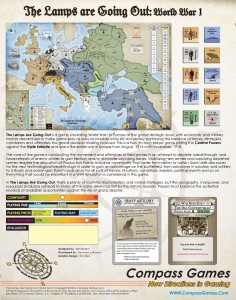 TE Aid to Russia: There is no way at the start of the game for the TE player to transfer PPs to Russia. The small amount the allies historically sent to Russia via Murmansk and Archangel is reflected in the Russian PP production and in the Tech cards. During play, there are two ways to transfer PPs to Russia:
TE Aid to Russia: There is no way at the start of the game for the TE player to transfer PPs to Russia. The small amount the allies historically sent to Russia via Murmansk and Archangel is reflected in the Russian PP production and in the Tech cards. During play, there are two ways to transfer PPs to Russia:
- If Turkey is conquered, then Anatolia and Gallipoli are TE-controlled and thus a Sea route can be established to the Russian port areas;
- Tracing a Sea route to Greece with Salonika “open” or with Greece as an actual ally. Then an overland route could be traced through a combination of allied and/or conquered and/or neutral areas to Russia.
- Romania Joining Via Brusilov Offensive: If a successful Brusilov Offensive attack is launched and compels Romania to join the TE, the actual entry of Romania and the deployment of its armies does not occur until the following turn (per the normal Neutral nation entry rules).
- US Use of WA Tanks and Heavy Artillery: US units may use any Fresh/Ready WA Tanks and/or Heavy Artillery units that share an area with them. Using them will spend them normally and thus make them unavailable to the WA player in the next game turn as Refreshing/Refitting them occurs only at the end of the WA turn.
- Mine Exploded: This Event card has a marker because the effect can be used in the current turn or held for use in any future turn WA Combat Phase.
Central Powers Starvation: During the CA Production Phase, Austria-Hungary (only) will have one additional PP available. Place a “1 PP Transfer” marker in Vienna when this card is drawn as a reminder. Also place the “CP Starvation” marker in Berlin as a reminder that Germany has to deduct 2 PP from its total PP availability next turn.
- Albania: A unit may only retreat into Albania if there is no other possible option. This includes a WA unit retreating into Greece with another WA unit already there (see #3 above) – the unit may not retreat into Albania because retreating into Greece is still an option.
Event Summaries and Clarifications:
21: Germany: FIRST LINE FORMATIONS (1914-1915)
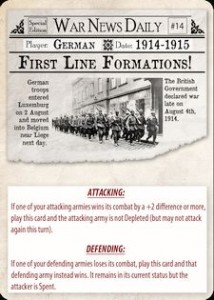 Place on a German army. When the attached army is committed as either attacker or defender, the army will receive a +2 modifier on its combat roll. Remove the First Line Formations marker after combat regardless of the result. The German FLF may instead be used to deploy one trench marker, even in 1914. Remove the FLF marker and place a German trench in the same area. If the FLF marker has not been used at the end of 1915, it is removed. If drawn after 1915, discard with no effect.
Place on a German army. When the attached army is committed as either attacker or defender, the army will receive a +2 modifier on its combat roll. Remove the First Line Formations marker after combat regardless of the result. The German FLF may instead be used to deploy one trench marker, even in 1914. Remove the FLF marker and place a German trench in the same area. If the FLF marker has not been used at the end of 1915, it is removed. If drawn after 1915, discard with no effect.
22: Germany: EAST ASIA SQUADRON (1914-1915)
Place marker near the British Isles to indicate it is active. During the Western Allies combat phase they may choose to attempt to eliminate the squadron by spending one British fleet (flip from Fresh to Spent) and rolling one die. If the rolled result is 3 or higher, the East Asia Squadron is eliminated and the marker is removed from the board. During the Western Allies production phase, if the East Asia Squadron is still active, a die roll is made and Great Britain’s production is reduced by 1 on a result of 5 or 6. The East Asia Squadron marker is removed at the end of 1915 regardless. If drawn after 1915, discard with no effect.
23: Germany: HINDENBURG-LUDENDORFF TEAM (1914-1915)
Roll one extra combat die for up to two German attacks this turn from either Prussia or Posen but not both. The decision to roll an extra die can be made with any attack combat you wish by an eligible unit and must be declared before any die rolls are actually made in that combat. If drawn after 1915, discard with no effect.
24: Western Allies: FIRST LINE FORMATIONS (1914-1915)
Place on a Western Allies army. When the attached army is committed as either attacker or defender, the army will receive a +2 modifier on its combat roll. Remove the First Line Formations marker after combat regardless of the result. If the FLF marker has not been used at the end of 1915, it is removed. If drawn after 1915, discard with no effect.
25: Western Allies: OLD CONTEMPTIBLES! (1914-1915)
Place on the British 1st/BEF army. The first time the British 1st/BEF is designated as the defending unit in a combat and has the Old Contemptibles marker, all defensive dice must be rerolled if the British 1st did not win the initial combat roll. The Old Contemptibles marker is removed regardless of the result or whether the reroll was needed. So the first time the BEF is defending and has the Old Contemptibles marker, the marker will always be removed after that combat is resolved. The marker is also removed at the end of 1915 if it has not been used. Ignore if drawn after 1915.
26: Western Allies: PANTALONS ROUGE (1914)
A mandatory attack by a French army must be made this turn and a -1 modifier applied to that army’s attack roll. If combined with the first turn Plan XVII rule, two separate -1 modifier attacks must be made. No effect if drawn after 1914.
27: Central Allies: FIRST LINE FORMATIONS! (1914-1915)
Place on a Central Allies army. When the attached army is committed as either attacker or defender, the army will receive a +2 modifier on its combat roll. Remove the First Line Formations marker after combat regardless of the result. If the FLF marker has not been used at the end of 1915, it is removed. If drawn after 1915, discard with no effect.
28: Central Allies: BALKAN WAR VETERANS! (1914+)
Any Serbian armies defending this turn during the upcoming Central Allies combat phase receive a +1 modifier to all their defensive combat rolls.
29: Central Allies: SKODA WORKS (1914-1915)
If A1 Technology is currently not active for the Central Powers, then place one Austro-Hungarian Heavy Artillery unit (if available – AH only has two maximum) in any AH area containing an AH army. If A1 Technology is currently active, then one “fired” AH Heavy Artillery unit may immediately be reset to “Ready.” The first AH Heavy Artillery attack made this turn has an automatic roll of 6 – no die roll is necessary. Ignore this card if drawn after 1915.


